It was the memory of Harold Paris that first connected me with Kevan Jenson. He was Harold's student and I his close friend. Paris was a sculptor, printmaker, painter, performance artist and one of the first sculptors to create in 1965, an art environment. He believed in art as process and constantly set himself new problems, working with new and different mediums, some of his own invention. Especially in his late work, before his untimely death at fifty-three, his work was endowed with a sense of the tragic and the sublime. It affected me as a critic and inspired Jenson as an artist. When Jenson and I met and prepared this exhibition, our discussion frequently centered on Harold Paris.
The first thing you notice in Jenson's paintings is that they are done with smoke. This could easily be a gimmick. So much of the art we encounter these days is contrived and trendy — misconstrued Duchamp. Marcel Duchamp, Jenson tells us, was his first "inspiration after I became disenchanted with science." Like Duchamp, Jenson puts intuition guided by an informed mind to work in his art. Paul Klee had it right, when he published his Bauhaus essays under the title The Thinking Eye. Jenson, like the best of the Action Painters anchors his work on basic structure, which in his work includes often vibrant color underpainting. Working in the 21st century he is aware of Chaos Theory and utilizes some chaos-structured concepts in his painting with smoke. He also leaves space for what he calls the "mythic realm." Smoke is not palpable. Being intangible and vaporous, it tends toward the "ethereal" which Jenson says he wants to avoid. But he knows how to make magic. In his best paintings he channels the smoke into what Harold Rosenberg, writing about Pollock, called "The Mythic Act."
— Peter Selz
The following conversation between Peter Selz and Kevan Jenson, with Paul Karlstrom (former West Coast Director of the Archives of American Art) was recorded on February 8, 2008. This essay first appeared in the catalogue published for an exhibition of Jenson's works curated by Peter Selz at the Meridian Gallery, San Francisco.
PS: We are talking in Kevan Jenson's studio in Venice, California and the first thing I'd like to discuss is your photograms. I became very interested in photograms at the The Institute of Design in Chicago going back to the days of Moholy-Nagy and the Bauhaus. He was one of the first to make photograms, images without a negative, then of course Man Ray took up the idea and did his wonderful Rayograms. Moholy-Nagy was more modest and didn't use his name. I'm delighted to see someone using photography in a different way; I'm looking at them now and they're unbelievable.
KJ: I'm happy you are enjoying them.
PS: The process still seems mysterious, how do you make these photograms?
KJ: Actually the technique is rather simple. I take a piece of tempered glass and apply smoke with a flame that comes from various torches, candlewicks or what have you, to one side of the glass. The smoke is collected on the surface and I make a pattern or drawing with the flame. Then I flip the glass over so that the smoke, taking the place of emulsion, is up. Next I make a contact print through the glass onto photopaper. So what we see is a reverse of the smoke: where the smoke is densest and darkest on the glass becomes the lightest part of the finished photogram. Conversely areas where the smoke is lightly applied, end up darker. I usually make three to five versions of each glass image; the versions vary because I manipulate the light source.
PS: Do you know before the finished product, what it's going to look like.
KJ: I have a structure in mind. In all of my work I try to create a landscape-like template, so the eye is led around the image, as in a Poussin for example. I may include a foreground element, encouraging the eye to spiral away into the distance. I attempt this, but I’m not always successful! I often leave an open section to imply another space, what I think of as a mythic realm. There is a bit of haphazardness to smoke and in the photograms I experiment freely.
PS: So in a way it’s a controlled accident?
KJ: It can be frustrating working with smoke because the slightest breeze will take the flame and the smoke in a direction you may not want to go, but I enjoy the frustrations. There’s a bit of chaos in the process that allows for pleasant surprises.
PS: How did you get interested in smoke?
KJ: My interest goes back to my days at Berkeley studying in the art department and working closely with Harold Paris for a time. As you know he was a master etcher and I was studying printmaking. Harold showed me a very traditional way of working with the ground, smoking the thinly applied asphaltum, with tapers. Most etchers use a ridiculously thick ground. With his ground you can produce very fine lines and see them as you work, because the smoke provides contrasting dark to the bright metal. His technique was very refined.
PS: Harold had a lot of good techniques in his head.
KJ: Indeed! He was encyclopedic.
PS: How did this lead to your painting with smoke?
KJ: I became fascinated with the smoking process. I must have done some experimental drawings with the candle tapers, not thinking much of it at the time, but three or four years later I settled into smoke, fell in love with the process and imagery it could produce. I looked at Yves Klein’s fire paintings as well.
PS: I was going to ask you about Klein, but first I have to ask you about Wolfgang Paalen, who was, as far as I can tell, the first person to work with smoke. Then Breton picked up on it as one of the interesting incident or accidental methods of Surrealism.
KJ: Fumage and frotage, decalomania, also collage…
PS: That's right…
KJ: I didn't become aware of Wolfgang Paalen until much later. It was Surrealism as a whole that felt important to me.
PS: But you knew of Yves Klein?
KJ: Yes I was very interested in his Fire Paintings.
PS: Of course he was more famous for his IKB [International Klein Blue] paint and having naked girls printing themselves onto canvas with it. There is a photograph of Yves with big torches going right into the camera lens. He used fire and smoke to great effect on canvas but these works were more performance oriented, where as you seem more interested in the final image produced.
KJ: His process was akin to Action Painting, dramatic like Pollock's process. For my generation the image in Life magazine by Hans Namuth, of Pollock with a cigarette, splashing paint, motivated many young people to pursue painting. It felt like a noble, masculine American thing to do. Of course not everybody could drip paint! You had to find your own way. The image of Klein with a flame-thrower pointed out a path for me.
PS: Klein, Pollock and others introduce the interesting idea of not directly touching the canvas, which you investigate as well. Klein did a similar thing using naked girls to make an imprint but without his personal touch. He didn't even want to touch the girls! Can you describe your process of working with smoke on canvas?
KJ: There is an ironic similarity to drip painting. Since smoke rises I end up flinging an image up. The painting has to be suspended overhead. I think it's a much gentler encounter. I often prepare the canvas with a ground, then an underpainting and glazing in a variety of colors and forms that create the structure under the smoke. Typically the final layer of glaze contains the smoke, applied while that layer is still tacky. As that layer dries it seals in the smoke. Gentle breezes and the turbulent nature inherent to flames and smoke bring a little chaos into play.
PS: Antiquity, how did it start?
KJ: I have an obsession with Claude Lorrain and his school of landscape painting that goes back to my time with Harold Paris. At that time he was very interested in Claude. Harold produced some intriguing collages with images from Claude's landscapes. I remember being struck by how beautiful those Claudes are. This was my first exposure to French/Italian landscapes. In my thinking Claude was the poet as opposed to Poussin the intellectual and I'm drawn to the poetic.
PS: You're right about Claude and Poussin and I see the poetic in your work.
KJ: I've looked at Claude for years. About 20 years ago, I traveled to Philadelphia to see a major retrospective. I've also looked closely at his extraordinarily lyrical drawings. Sometimes I use his work as a template, as did Turner. Even during the application of the smoke I can reinforce that landscape structure. In the case of Antiquity I referenced a Claude seascape.
PS: So how much of that seascape are we seeing here?
KJ: We are definitely seeing it in the underpainting. All the dark smoke elements on top are not part of what I'm calling the structure. There's a legend that Pollock drew images underneath his mature paintings and then covered them with drips. I think that lends structure to what appears at first glance to be a random splattering of paint. Some part of the mind sees that pentimento. In my work there's a similar process that allows the mind to linger in the qualitatively ephemeral smoke. Does that make sense?
PS: It makes perfect sense. It's not just letting go. This painting wouldn't be as good as it is just by letting go.
KJ: Just pattern making on the surface with smoke would be uninteresting to me. I think when a painter indulges in mere pattern making, mere surface effect, you miss part of the western art tradition, which is the imaginative realm Surrealism taps into.
PS: Now this painting, what is it called?
KJ: That's called Rock Bottom. It's a grey mid-sized smoke painting, a very spare work that is just smoke over acrylic gesso.
PS: Can we see the ground?
KJ: The entire background color, the brush strokes, the slight impasto from a spatula. is the acrylic ground. Then I laid over a glaze, that is what the smoke adhered to. Here it's a glaze, with only a trace of color. It's a very simple painting.
PS: It may be a simple process, but the effect is intricate. How long does it take to make a painting like this?
KJ: After the ground was prepared, the actual smoking process is fairly quick. Sometimes I will let a painting dry then apply another layer of glazing, go back and smoke again, so maybe a couple of days in total.
PS: The white area in the center, what are we seeing?
KJ: That's the ground showing through the glaze.
PS: And you move the torch so there is no smoke there?
KJ: Yes.
PS: So you have the canvas on top of you?
KJ: The painting has to be overhead or at least leaning over, since smoke goes up. Sometimes I angle the canvas to get the smoke to flow in a particular direction, my rig allows that. I have a variety of tools that shoot the smoke out, like an airbrush. Here’s a little lab torch that squirts a flame out. [KJ produces a plastic squeeze bottle with a wick and an air tube.]
PS: And you do this in your studio or outside?
KJ: Usually here in the studio, there’s a big open door to vent the smoke.
PS: The white lines that appear and hard edges, that’s not just from the torch is it?
KJ: No, I use rope, string, pieces of wood, sometimes tape to mask and manipulate the smoke. Many of my recent works have rays as I call them, cutting through the image.
PS: I’d like to revisit Antiquity: In that painting you present a big, open space, an amazing realm of some sort. What is your intent?
KJ: There’s an historical thread that I fantasize I’m connected to. It’s the western tradition of painting that runs clear through from Lascaux to California. Even though I’m a West Coast guy, and have read my share of Zen, I feel tied to the western European psyche. The idea in Antiquity was to take an image from that tradition and show that even in the chaos of modern life, there’s still a thread of the Hellenic, the Mediterranean. I leave it unspecified exactly how that plays out, but it’s there. I applied many glazes to develop that space, some featuring fluorescent pigments to spice up the color. The result is a very vibrant underpainting. When I’m ready, and how that determination is made I still can’t figure out…
PS: You apply the smoke.
KJ: Yes. The smoke is applied in a very conscious way to leave open certain areas so the eye will flow. In this painting I did something I don’t often do, I glazed over the smoke layer with a thin fluorescent pink layer, so some of the smokey zones also have a pink cast.
PS: I can see that. Harold Paris got you onto Claude?
KJ: Yes he did. I wasn’t versed in the history of art then, just a young student. Witnessing how Harold reimagined art, by connecting to and researching earlier artists, was an exciting lesson.
PS: I wish Harold could have seen these paintings, because he would have loved them. I can tell he would have really felt a sense of continuity.
KJ: I met him at a very interesting point in my life when I wanted to become an artist, but had no idea how to do it. I went through this short time working with Harold, as an assistant, and I picked up a deep sense that I was being connected to some tradition through him. And after he passed away I maintained the sentiment of a connection through him to a line of artists, despite the brevity of our time together.
PS: Harold had this connection you describe. He never formally studied art history, but he had this wonderful connection to his art, to art history, to the whole western tradition, as well as primitive and ethnic art. His was a constantly searching mind that I think you have acceded to this fabric of his mind.
KJ: I do feel connected! Harold was an intensely intellectual guy, very passionate and inspirational. He had an outsized personality that I meshed with. My own family is full of such personalities so I liked that intensity in him. Even though we only worked together for that short time, we had many conversations about art, about what it means to be an artist, about his experiences, about what he felt was good art and even what he felt was crap!
PS: Harold did let you know his opinions! After he died you went to New York?
KJ: I did. I stayed at Cal another year and then I felt such an absence that I just moved to New York.
PS: What happened there?
KJ: I rented a studio.
PS: How long were you there?
KJ: I lived there about five years. I had a studio in Brooklyn for a little while, then a studio in Chelsea above a punk recording studio. This was from ’80 to ’85.
PS: Before there was much of a Chelsea.
KJ: There was nothing there. For me it was terrible! I was trying to connect to the art world and ended up driving a yellow cab to make a living. But as you know to become a painter, at some point you either have to drive a cab or work as a cook.
PS: That’s right!
KJ: I chose the road less taken, the cab driving path.
PS: That’s an education from street level and certainly a valuable one. Who where the artists that interested you at that point?
KJ: Of the living artists, Schnabel was doing interesting work, also Bruce Nauman, Clemente. I loved Henri Michaux! Yet I felt more connected to the music of the time than the art.
PS: Jazz ?
KJ: I was a musician as a young person and there was a group of improvisational jazz players in New York at that time…
PS: Yes, a sort of wild free music?
KJ: Very improvisational. My studio was in a space where many of them practiced and recorded including Arto Lindsay and Glenn Branca, whose guitar orchestra blasted me out of my studio one day. They were doing something in music that I wanted to do in painting: taking western forms and pushing them to the limit and coming up with a violent contemporary result. They didn’t go off into an ethereal space, a place I find very uninteresting in both art and music. It's funny to say, because smoke can easily become ethereal.
PS: Not when you hit it down on the canvas. It's no longer ethereal, there it is, very much a substance.
KJ: That's true! I spent a lot of time at the Met and the Brooklyn Museum trying to get a handle on these notions. Even though I was exposed to art and my family was very cultured, there's nothing like getting slammed by New York City, nothing like spending an hour in front of a Pollock every month or so. I'd go to the Met and sit in front of Autumn Rhythm then go off and look at some medieval altarpiece.
PS: It's interesting that you went to the Met rather than to MoMA.
KJ: Well I did go to MoMA a few times, but…
PS: But the Met was more important to you.
KJ: Well MoMA's was a tradition I knew. I had studied it and knew every piece there. I loved all those works but I wanted to dip into stuff I didn't know.
PS: That makes a lot of sense. Did you try the galleries?
KJ: I tried. It was very difficult to get in. I wasn't coming from a place they could figure out. I didn't have an MFA, I just went innocently around in a city that just eats that for lunch. I had a tough time.
PS: Then you came back to LA and started working with smoke?
KJ: Yes, I did a little smoke work in NY, not much. When I arrived back here in '85 I immediately did a smoke painting called The Occult.
PS: Oh yes the circular galaxy-like work.
KJ: I think being in LA was the missing part of the equation for me. LA has a fire landscape; we have an ecology and psychology of fire here.
PS: In Los Angeles, that goes back all the way to the native cultures, doesn't it?
KJ: The Chumash [an indigenous people historically inhabiting central and southern California] were in touch with this aspect of the landscape. These hills are constantly burning. They performed temescals, that is smoke healing ceremonies, and set preventive fires. I'm not specifically tied to any of this, but it lends some weight to my ideas about painting with smoke. There is a ritualistic part of using fire as a tool. I got into smoke upon arrival back in LA and haven't stopped.
PS: Looking again at Antiquity, why is it pink?
KJ: Why is it pink? (laughs)
PS: It's a fire, right?
KJ: Yes and it's also a sunset, a magic hour.
PS: Absolutely. I see the magic of fire in it. Let's look at some more paintings. Now we are looking at a large horizontal piece, what do you call this one?
KJ: Lunatic Fringe Acceptance Mechanism.
PS: Why does it have that funny title?
KJ: Well, I started at Cal in math and physics…
PS: And astronomy too, right?
KJ: Yes astronomy too. Many nights around 3am, I ask myself why I left math and physics for the enigmas of art! After my first quarter at Cal, I had finished all of the required undergraduate courses for a math degree, I only needed to take a few electives.
PS: Oh my god, really?
KJ: I was studying with a group who were working on the ideas that later became Chaos Theory. Beautiful minds, hippies, stoners. And they were doing incredible work with differential equations. I'm sure I couldn't do any of the math now if I tried!
PS: Chaos Theory, that's the idea that there are many levels of disorganization?
KJ: Yes it's a beautiful concept. They described how systems behave as they get pushed beyond certain limits and disintegrate into orders of chaos. This plays into my smoke imagery. For me it's important to remember that art, science, alchemy and memory systems all came out of a kind of united front back in the Renaissance.
PS: A united front, that's good!
KJ: And then the front split apart, but psychologically there are threads linking each of these pursuits together. It's all part of our western psychology. I've worked very closely with the psychologist James Hillman, who is a post-Jungian American psychologist, now in his early eighties. He Americanized Jungian thought, into what he calls "Depth Psychology." Hillman's work delves into this Neo-Platonic world.
PS: In what capacity did you work together?
KJ: For the record, I was not a patient.
PS: I think that's a good thing.
KJ: I produced and directed a couple of documentaries featuring him and we worked on a detailed project about Duchamp's Étant Donnés.
PS: You know Sam Francis was very much involved with Carl Jung and psychic energy.
KJ: There's a book published by Sam Francis, called Pacific Wall written by Lyotard. A fantastic essay about the feminine in Los Angeles, the interplay of chaos, and how the landscape plays that out. These ideas are really very deep in my work. I think a lot about a dark feminine presence, you can see the figure in Étant Donnés. Duchamp was my inspiration to enter art after I became disenchanted with science. I looked at the Large Glass and thought "this is a space I can work in." I'd lost my interest in science but I wanted to find a way to use intellect in art. I saw, even as an 18 year old, a common misunderstanding of Dada and Surrealism. I think they were seen as automatic processes, unconscious work, but there's a conscious intellectual thread there. I also saw a buried feminine psychology. She had descended Duchamp's staircase and disappeared into the Large Glass and got torn up by the World Wars but she was there. I was in Mexico City on a sojourn of sorts to find myself as an artist and read Cabanne's Dialogues with Marcel Duchamp and I found what I was looking for. Then I went back to Cal, worked with Harold and connected with Surrealism at a personal level. I think you can see that dark feminine space in Harold's black rooms. I feel it was missing from minimalism and pop, which are beautiful in their own way, but just don't grab me.
PS: Those Lichtensteins are so boring, my god! And then of course it gets much worse with all these contemporaries…
At this point Paul Karlstrom enters the discussion.
Paul Karlstrom: Of course Kevan may be a big fan of Jeff Koons.
KJ: Oh sure, some of is work is really humorous. That giant topiary bunny or the porcelain porno stuff, there's a neurotic insanity to that.
PS: That's right.
PK: You've got to admire that, I guess. I'm always interested when talking with artists how they see themselves within this world we're describing because there are many, many different avenues that have been taken and yours is…
KJ: The road less traveled?
PK: Highly individualistic.
PS: This is exactly what I like about your work.
KJ: When I got back to Cal I was 19 years old or so, working with Harold, meeting extraordinary artists like Arnaldo Pomodoro…
PK: Peter Selz, did you ever meet him?
KJ: I did meet Peter back then. I was working a bit for some galleries, and for me the experience was like an incredible door opening. When Harold passed away the door just closed and I didn’t think it was going to open again in the Bay Area. So I left for New York, left college and began what I think of as my American Odyssey: working in NY, my salad days, later coming back to LA where I got involved in the film industry. I have worked with some really interesting directors: Wim Wenders and David Lynch stand out among many.
PS: Oh wow!
PK: Some of my favorites.
KJ: Very interesting fellows.
PS: What did you do on these projects?
KJ: I did video engineering. At that time I had very little traction as an artist, only my wife Maria’s enthusiasm to sustain me. No connection to a gallery, completely on the outside. I think I’m still there.
PK: Well I don’t know. You’ve got Peter Selz in your studio.
KJ: That’s true.
PS: And now I’m curating your show.
KJ: Harold used to say: “if the miraculous doesn’t happen from time to time, you’re leading the wrong life.” And Peter, your interest and enthusiasm feels miraculous.
PK: If you had to place yourself within recent and contemporary art, thinking of some of the more visible artists, how do you see yourself, your direction, because you are obviously well informed and pay attention to what out there?
KJ: Well it may sound far fetched, but now, about 30 years after working with Harold Paris, I find my psychology as an artist still rooted by that experience. He once told me, “Look Kevan, I don’t see you making art that you’ve got to plug into a wall.” That statement hit me and I’ve held it for 30 years. I don’t do video art. I don’t to do installations.
PK: No fluorescent tubes?
KJ: No fluorescent tubes for me. As a rule I don’t use the word authentic, but there’s something about working with paint that is, well, timeless. Peter expressed it better recently, he said: “painting’s been around since Lascaux and I think it will be around for a bit longer”.
PK: But you have worked with some very interesting filmmakers, I’m surprised you’re not interested in video or film.
KJ: There is some great video art out there for sure. One of the more interesting video artists working today is Shirin Neshat, do you know her?
PK: No I don’t.
KJ: She is an Iranian woman working on the repressed feminine image in Islam, akin to my ideas of the dark feminine. She was a co-student with me in Harold Paris’s classes. Like me, I think she found a thread back then and is now expressing it in video. I have great admiration for her work in that medium –it’s just not for me.
PK: Since you profess an affinity to painting, have any painters had an effect on you?
KJ: I think Richter does some beautiful abstractions. I saw a few of his paintings in New York 25 years ago, and thought they looked like Franz Kline’s work, but they made me think about the viability of abstraction.
PS: Yes, but they are a little too slick for me.
PK: Like that disaster at the De Young.
PS: Disaster?
PK: That big wall installation? ?
PS: Oh, that’s horrible!
PK: It doesn’t even look anything like a work of art!
KJ: You mean the big giant one? Oh, I kind of like it.
PS: Kevan, your work is coming from an emotional dimension that is unfashionable to some, particularly in LA.
KJ: Perhaps that dimension emanates from the LA I grew up in: the LA of Thomas Mann, of Schoenberg, an LA shaped by the great intellectual Diasporas from Europe around WWII. Also I’m half Jewish, half Latin, which is quintessentially Angeleno. My father, a fan of German writing, was forever perfecting his dissertation on The Magic Mountain. My family is full of classical musicians. So I was immersed in the Germanic; listening to Bach, Beethoven, Brahms, later I read Brecht, Rilke, Mann. In fact Doctor Faustus probably shoved me over the edge into the arts! LA has a history of cultural insemination from that era. For example you can hear it in the film composers working today. There were others who came, like Duchamp for his retrospective, or the great instrumentalists like Heifetz and Piatiagorsky – I remember seeing them in white jackets performing at the Hollywood Bowl. All of these people impacted LA but their presence is fading away. As a result I feel a bit out of sorts in my own town because the younger generation doesn’t have a correlating narrative.
PS: You’re right, you’re right, that time is over.
KJ: I’m a bit sad about it. I always felt it was a valuable tradition.
PK: It’s not going to be erased because here you are working with that in mind.
KJ: That’s a great compliment.
PK: And obviously it’s very serious work, not trendy.
KJ: There’s something very intense about working out a big painting. As unfashionable as emotion has become while working, while in process, it remains the main draw for me. You pull something out of your soul; try to bring up an image that others can connect with. That process, that digging in your soul or in the soul of the world, that’s what I’m committed to.
PK: What is this dark feminine you talk about? You’ve got me really interested in that.
KJ: Some of that idea comes from Lyotard’s Pacific Wall. It’s a crazy fictional biography about LA’s fractal mindset. David Lynch’s films touch on a similar erotic, unstructured, Dionysian vision of LA.
PK: People who have overly structured ideas of cities seem to feel uncomfortable in LA.
KJ: You mean in our unstructured mess?
PK: You haven’t said that yours are LA paintings, but is there something you are investigating that correlates?
PS: What about this one here?
KJ: That one is called Toloache, (illus. pg 23) a Náhuatl word for a drink made from datura. Native Americans in this region drank it to get intoxicated. This painting is intended to evoke a psychedelic state, of course that’s a big part of LA. It’s from ’93 or so.
PK: It’s lovely.
KJ: Thank you.
PS: I see a rhythm in there, I see people dancing. I have that sense definitely.
KJ: It’s supposed to evoke a ritual moment.
PS: I see a wonderful cadence in this painting. Let’s go back to the big piece, Lunatic Fringe Acceptance Mechanism.
KJ: This is part of a series about a software engineer that disappeared at sea. All of his colleagues got together and tried to find him by mouse clicking on satellite photos of the ocean.
PS: What was his name?
KJ: Jim Gray, he was a very well known engineer. I have no connection to him personally, I’d never heard of him before coming across the story of his disappearance at sea while sailing his boat out of San Francisco Bay to the Farallon Islands to disperse his mother’s ashes at sea. I thought the idea of this guy disappearing in the great chaos of the ocean and the good natured naïveté of people trying to find him with a little mouse clicking, well it struck me.
PS: They didn’t go out in the ocean, they just looked at pictures?
KJ: Just looked at images from satellites. They enlarged them and looked for something funny, a bit of color and then sent the coordinates to the organizer of the search…
PS: …to try to find this guy?
KJ: There is something poetic and well innocent about that attempt to overwhelm the oceanic depths with a computer. The phrase “lunatic fringe acceptance mechanism” comes from one of Gray’s papers about including wild ideas into the software culture. He felt his professional community needed this kind of mechanism to allow for deep innovation.
PS: He disappeared near the Farallons you say?
KJ: Yes. He also went to Cal, years before me. I found the phrase looking through his writings. I think this piece might be some sort of monster or I don't know, maybe a sea creature.
PS: A big sea creature!
KJ: I wanted an image of a psychological demon that might emerge, Neptune like from the depths and swallow you whole.
PS: And you have this blue on the bottom like an ocean and blue sky at the top.
KJ: I think a space like that is implied. I masked the smoke with a rope to create the line, like one of those Renaissance annunciation rays.
PS: You have similar lines in that other painting from this series.
KJ: Off Farallon.
PS: That’s made about the same time about the some topic?
KJ: Yes the same series.
PS: Off Farallon is the beautiful blue painting with this big whorl I remember on the bottom.
KJ: I’m currently using a visceral paint, nothing fine-tuned. For the underpainting I’m just going at it in a very direct and emotional way, an abstract expressionist approach.
PS: In this Lunatic painting (illus. pg 17) I think the pink on the black, it works exceedingly well. Now the black is the smoke.
KJ: The black is smoke and there’s also a wine colored pigment used underneath some of the smoke. The chiaroscuro comes primarily from the smoke. The smoke also masks the underpainting and I think forces the viewer to complete the imagery in the mind.
PS: The way the smoke comes into this one is wonderful, it has a tremendous effect on me, that dark, black smoke.
KJ: Thank you Peter.
Smoke and Vapors
-
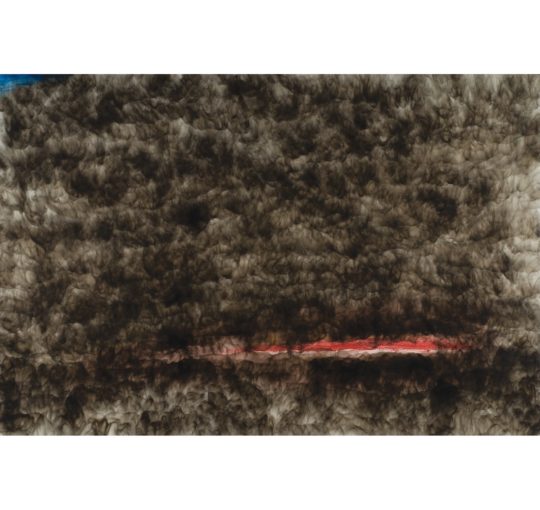 DETAILS
DETAILSAbendland, 2008
84 x 56.5 inches (213.36 x 143.51 cm) -
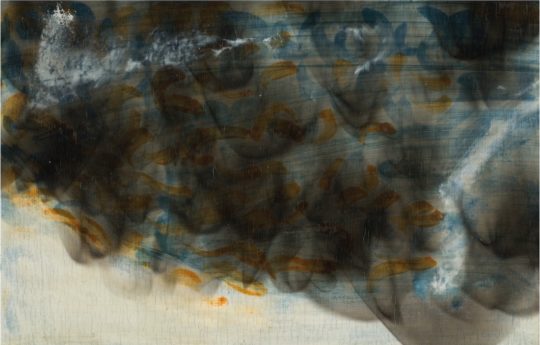 DETAILS
DETAILSAfter Constable, 2004
11.5 x 7.5 inches (29.21 x 19.05 cm) -
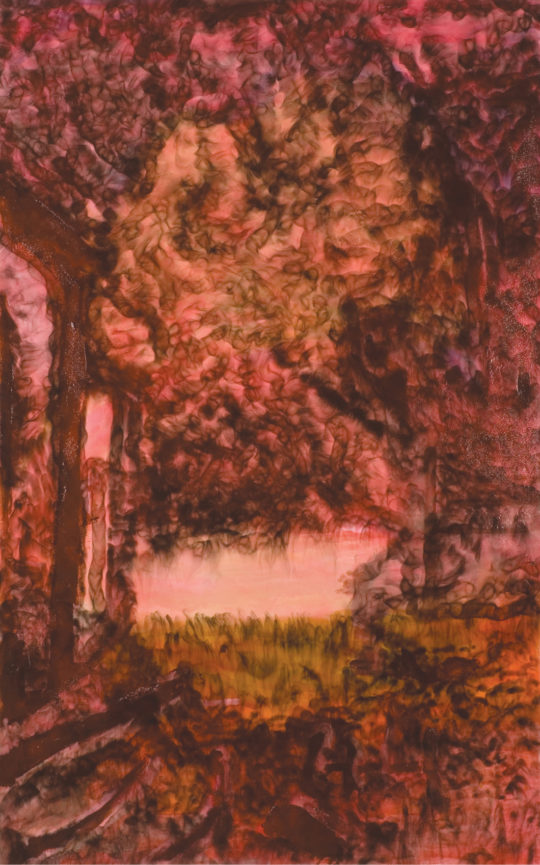 DETAILS
DETAILSAntiquity, 2007
60 x 96 inches (152.4 x 243.84 cm) -
 DETAILS
DETAILSGigaku, 2005
72 x 48 inches (182.88 x 121.92 cm) -
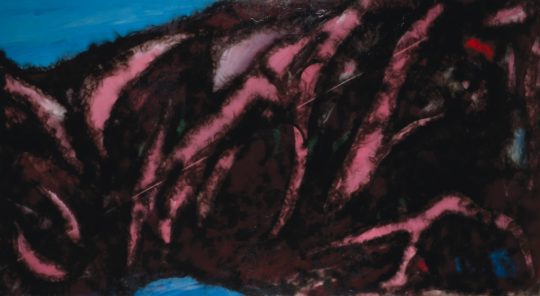 DETAILS
DETAILSLunatic Fringe Acceptance Mechanism, 2008
142 x 78 inches (360.68 x 198.12 cm) -
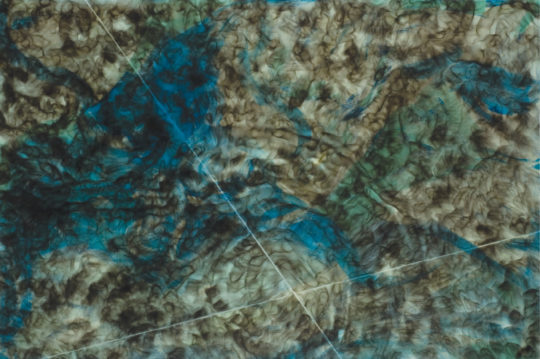 DETAILS
DETAILSOff Farallon, 2007
84 x 56 inches (213.36 x 142.24 cm) -
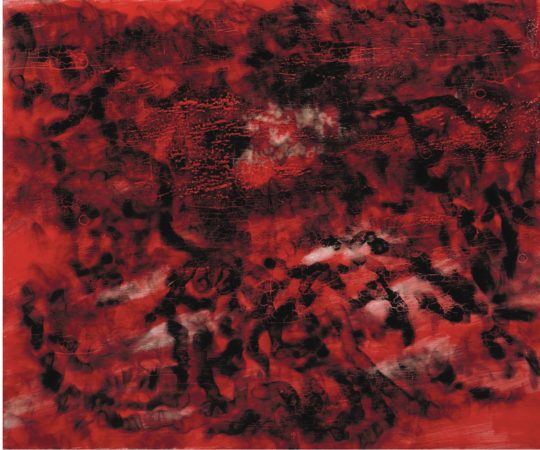 DETAILS
DETAILSPathologique, 1999
48 x 40 inches (121.92 x 101.6 cm) -
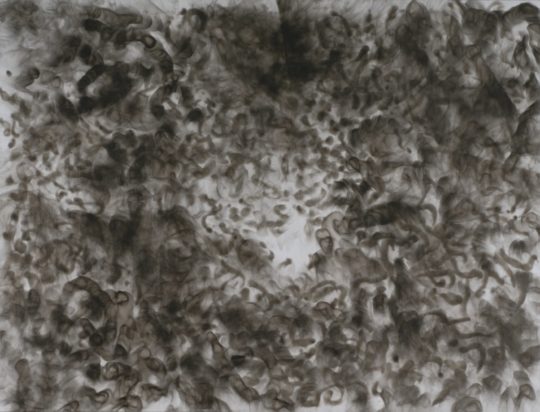 DETAILS
DETAILSRock Bottom, 2007
58 x 44 inches (147.32 x 111.76 cm) -
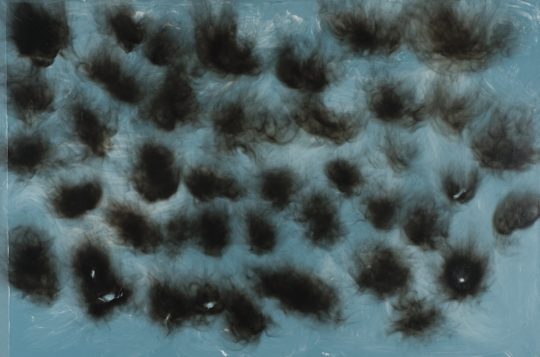 DETAILS
DETAILSSixty Years on August 2005, 2005
73 x 48 inches (185.42 x 121.92 cm) -
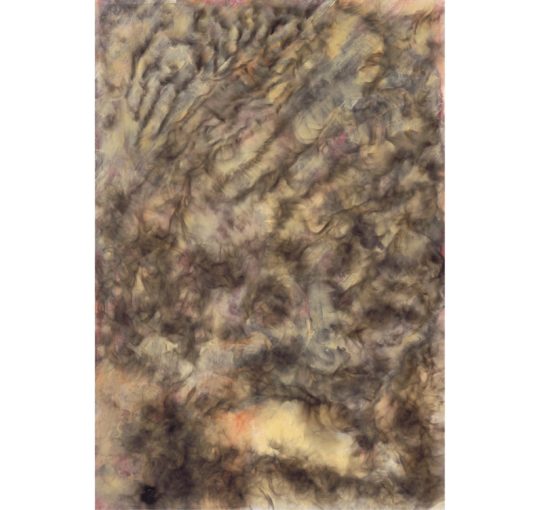 DETAILS
DETAILSThe Butterfly Effect, 1996
48 x 72 inches (121.92 x 182.88 cm) -
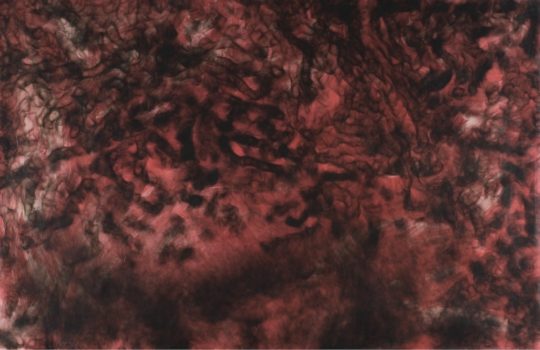 DETAILS
DETAILSToloache, 1992
80 x 51.5 inches (203.2 x 130.81 cm) -
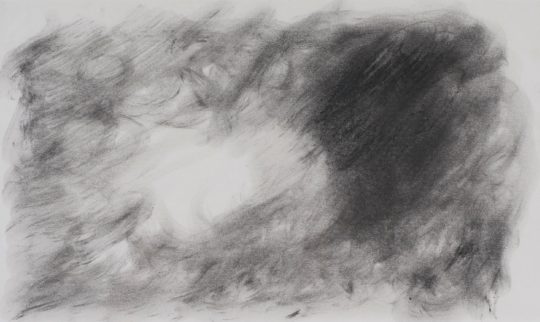 DETAILS
DETAILSUntitled, 1990
14 x 9 inches (35.56 x 22.86 cm) -
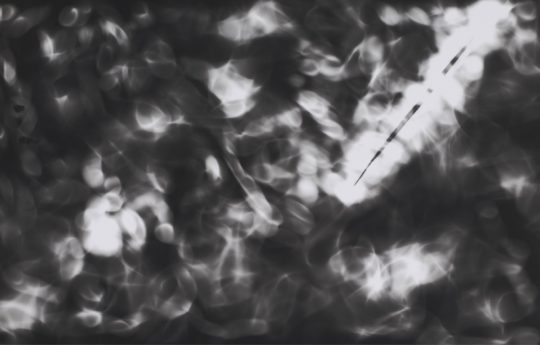 DETAILS
DETAILSUntitled, 1997
14 x 8.5 inches (35.56 x 21.59 cm) -
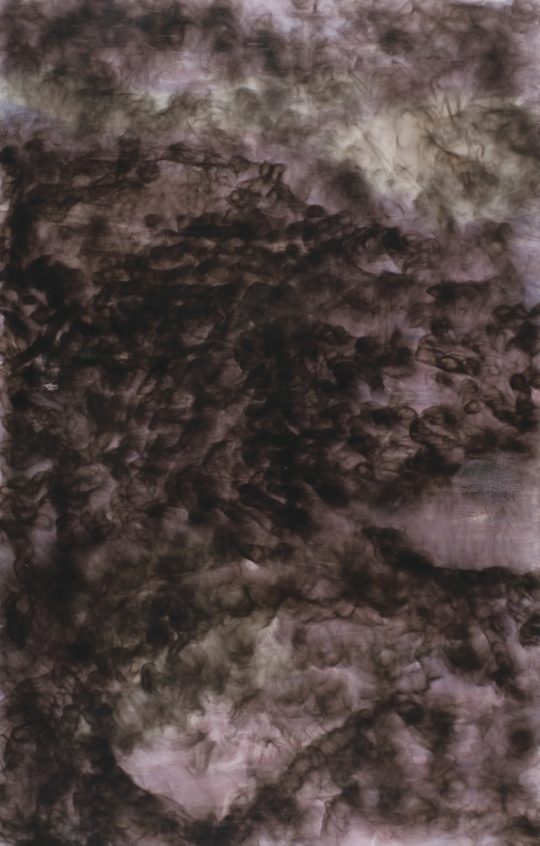 DETAILS
DETAILSWater in the cathedral, 1992
50.5 x 75.5 inches (128.27 x 191.77 cm)
-
 DETAILS
DETAILSAbendland, 2008
84 x 56.5 inches (213.36 x 143.51 cm) -
 DETAILS
DETAILSAfter Constable, 2004
11.5 x 7.5 inches (29.21 x 19.05 cm) -
 DETAILS
DETAILSAntiquity, 2007
60 x 96 inches (152.4 x 243.84 cm) -
 DETAILS
DETAILSGigaku, 2005
72 x 48 inches (182.88 x 121.92 cm) -
 DETAILS
DETAILSLunatic Fringe Acceptance Mechanism, 2008
142 x 78 inches (360.68 x 198.12 cm) -
 DETAILS
DETAILSOff Farallon, 2007
84 x 56 inches (213.36 x 142.24 cm) -
 DETAILS
DETAILSPathologique, 1999
48 x 40 inches (121.92 x 101.6 cm) -
 DETAILS
DETAILSRock Bottom, 2007
58 x 44 inches (147.32 x 111.76 cm) -
 DETAILS
DETAILSSixty Years on August 2005, 2005
73 x 48 inches (185.42 x 121.92 cm) -
 DETAILS
DETAILSThe Butterfly Effect, 1996
48 x 72 inches (121.92 x 182.88 cm) -
 DETAILS
DETAILSToloache, 1992
80 x 51.5 inches (203.2 x 130.81 cm) -
 DETAILS
DETAILSUntitled, 1990
14 x 9 inches (35.56 x 22.86 cm) -
 DETAILS
DETAILSUntitled, 1997
14 x 8.5 inches (35.56 x 21.59 cm) -
 DETAILS
DETAILSWater in the cathedral, 1992
50.5 x 75.5 inches (128.27 x 191.77 cm)
No Press releases found.
No Events Found.

